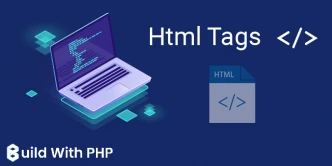HTML Form
calendar_month 26 May 2020 | HTML
An Html Form is used when we want to collect data from visitors of a website to the server-side. For example, if a user wants to register on your website, then you would like to collect his information like name, phone no, email address, etc.
A form will collect inputs from the website visitors and then will post it to backend applications such as PHP, ASP, etc.
Html form is create by using <form> Form tag. It contains different types of elements like text fields, check-boxes, radio-buttons, drop-down menu (select-box), label, textarea, submit button, etc.
You can use these elements in your form according to requirements.
The basic structure of an Html form is thusly:
<form action="posturl.php" method = "POST">
form elements
</form>
HTML Form Tags
| Sr.No | Tag | Description |
|---|---|---|
| 1 | <form> | The element defines an HTML to collect user input. |
| 2 | <label> | It is a useful element for a screen-reader that defines a label for an input element. |
| 3 | <input> | It is the most important form element that defines an input control and allows the user to input. |
| 4 | <textarea> | It specifies a multi-line input field (a text area) can contain more characters than <input> element. |
| 5 | <fieldset> | The <fieldset> element is used to group similar data. |
| 6 | <legend> | The <legend> element is used to define a caption for a <fieldset> element. |
| 7 | <select> | It is used to define a drop-down list. |
| 8 | <option> | It is used to define an option that can be selected by the drop-down list. |
| 9 | <optgroup> | It is used to define a group of related options in a drop-down list. |
| 10 | <button> | It is used to define a clickable button to submit a form. |
Form Attributes
| Sr.No | Attribute | Description |
|---|---|---|
| 1 | action | It is used to specify the URL of the document where the data will be sent after the form is submitted. |
| 2 | method | The value of the method attribute of a form element instructs the browser how to submit form data to the server. There are two types of HTTP methods, which are GET and POST. |
| 3 | enctype |
You can use the enctype attribute to specify how the browser encodes the data before sending it to the server. Possible values are: (I). application/x-www-form-urlencoded - Default. (II). mutlipart/form-data - To load binary data in the form of files such as images, pdf files, etc. |
HTML Form Example:-
Ashwani Kumar
I'm a dedicated full-stack developer, entrepreneur, and proud owner of buildwithphp.com. I reside in India, where I draw inspiration to create helpful tutorials and tips for fellow artisans. I'm deeply passionate about technologies like Bootstrap, PHP, CodeIgniter, Laravel, Node, React, JavaScript, and jQuery. I believe in working hard consistently, which keeps me motivated and driven. Challenges are opportunities to learn, setbacks are lessons. I find inspiration in the endless potential of technology and aim to make a meaningful impact with my work.
Buddy! I hope you relished the tutorial, and it was good to see you again. Keep learning. Keep visiting.


